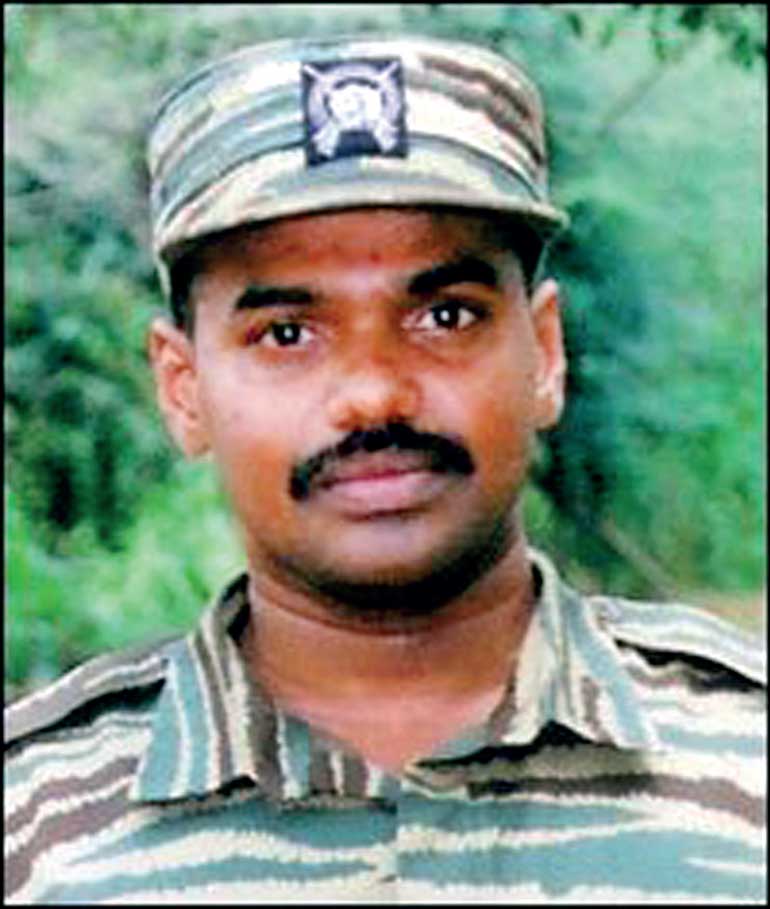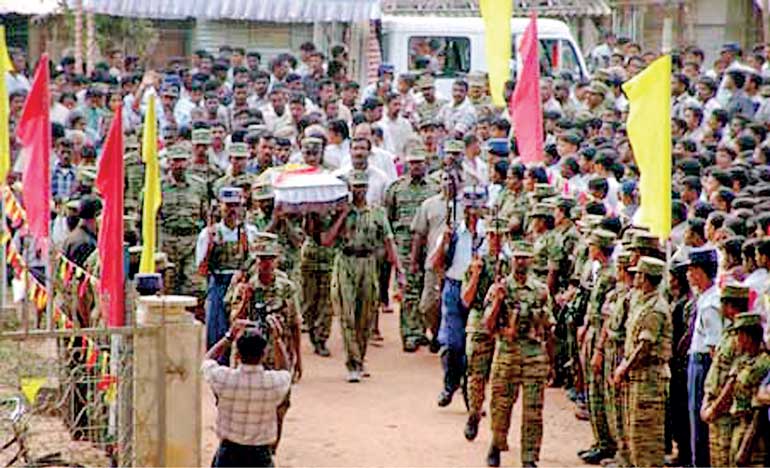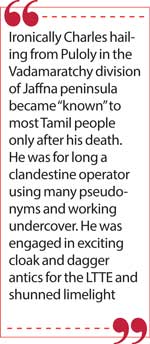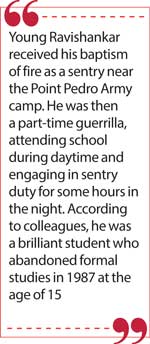Friday Apr 18, 2025
Friday Apr 18, 2025
Friday, 10 January 2025 00:40 - - {{hitsCtrl.values.hits}}

Shanmuganathan Ravishankar alias Col. Charles

Col. Charles’ funeral; leaving his home in Kilinochchi
 The Long Range Reconnaissance Patrol (LRRP) was a specialised military intelligence unit of the Sri Lankan army that was deployed by the State against the Liberation Tigers of Tamil Eelam (LTTE) during the armed conflict. Sri Lanka’s Long Range Reconnaissance Patrol (LRRP) was known in Sinhala as the “Digu Dura Vihidum Balakaya” and in Tamil as the “Aazha Ooduruvithaakkum Padaiyani”. It was also called the Deep Penetration Unit (DPU) and “Mahasonon Brigade of the Army”.
The Long Range Reconnaissance Patrol (LRRP) was a specialised military intelligence unit of the Sri Lankan army that was deployed by the State against the Liberation Tigers of Tamil Eelam (LTTE) during the armed conflict. Sri Lanka’s Long Range Reconnaissance Patrol (LRRP) was known in Sinhala as the “Digu Dura Vihidum Balakaya” and in Tamil as the “Aazha Ooduruvithaakkum Padaiyani”. It was also called the Deep Penetration Unit (DPU) and “Mahasonon Brigade of the Army”.
The LRRP was basically utilised for black ops. A black operation or black op is a covert or clandestine operation by a government agency, a military unit or a paramilitary organisation. Key features of a black operation are that it is secret and is not attributable to the organisation carrying it out. The usage of specialised military intelligence units to assassinate the enemy has been practised by different states and different armies in different situations.
Fundamentally, the Sri Lankan LRRP teams were a combination of disgruntled ex-Tigers, members of anti-Tiger Tamil militant groups, Muslim home guard/para-military operatives and carefully selected Sinhala personnel from the Special Forces. They were given highly specialised ‘Commando’ type training here and abroad.
Basic modus operandi of the LRRP was for small groups to clandestinely infiltrate territory controlled by the LTTE and target senior Tiger leaders and key operatives. LRRP operations were undertaken in both the northern and eastern Tiger-controlled regions during the war
 Among the prominent Tigers killed over the years were LTTE Batticaloa District Intelligence Head Lt. Col Nizam, LTTE Batticaloa-Amparai Communications Chief Major Mano, LTTE Air Wing Head Col. Shankar, Sea Tiger Deputy Commander Lt. Col Kangai Amaran, Lt. Col. Kumaran, who was manning defences in the Manal Aaru/Weli Oya region, artillery specialists Major Sathiyaseelan and Capt. Thevathasan.
Among the prominent Tigers killed over the years were LTTE Batticaloa District Intelligence Head Lt. Col Nizam, LTTE Batticaloa-Amparai Communications Chief Major Mano, LTTE Air Wing Head Col. Shankar, Sea Tiger Deputy Commander Lt. Col Kangai Amaran, Lt. Col. Kumaran, who was manning defences in the Manal Aaru/Weli Oya region, artillery specialists Major Sathiyaseelan and Capt. Thevathasan.
Shanmuganathan Ravishankar
However the crowning achievement of the LRRP was the killing of the then LTTE Military Intelligence Director Shanmuganathan Ravishankar alias Col Charles a.k.a. Arulvendhan who was killed in Mannar District on 5 January 2008. Charles was the scheming brain and guiding hand behind most attacks by the LTTE in the areas outside the North and East particularly Colombo. He masterminded the LTTE attack on the Katunayake Airport in July 2001.
At the time of his death, Ravishankar, alias Charles, held three leadership positions in the LTTE. He was Head of the Military Intelligence Division, he was in charge of all external operations and he was commander of a special combat unit engaged in the Mannar District. Charles also known as Arulventhan held Lt. Col. rank when killed. He was promoted posthumously as “Colonel.” His 17th death anniversary was on 5 January 2025. It is against this backdrop that this column focuses with the aid of earlier writings on Ravishankar alias “Col” Charles this week.
Charles was an amiable person with a pleasant disposition. Those who have interacted with him say that he was easy to get along with. He suffered from migraines and used to take Panadol regularly. LTTE colleagues nicknamed Charles/Arulventhan as “Panadol.”
 Charles to Arulventhan
Charles to Arulventhan
Ravishankar joined the LTTE in his early teens in December 1985. His original nom de guerre was Charles. Years later, when the LTTE underwent a ‘Pure Tamil’ transformation of names, the English name Charles was turned into Arulventhan. It was, however, as Charles that he was known for years to most people.
35-year-old Charles was travelling from Mulangaavil in Kilinochchi district to Pallamadu in Mannar district when his vehicle was hit by a claymore landmine. The white Hi-Ace van in which he was travelling along the Mannar-Pooneryn Road got caught in a claymore mine explosion at a spot between Iluppaikkadavai and Pallamadu.
The time was around 3:10 to 3:15 p.m. Three of the Military Intelligence Chief’s lieutenants were also killed in the ambush. They were Sukanthan (Sivapalan Sreetharan) from Jeyapuram, Veeramaravan (Pararajasingham Suthan) from Mallaavi and Kalai (Sinnaththamby Kangatharan) from Vaddakkachchi. Sukanthan was the chief bodyguard and close associate of Arulventhan/Charles.
Ironically Charles hailing from Puloly in the Vadamaratchy division of Jaffna peninsula became “known” to most Tamil people only after his death. He was for long a clandestine operator using many pseudonyms and working undercover. He was engaged in exciting cloak and dagger antics for the LTTE and shunned limelight.
Former LTTE sea tiger special commander “Col” Soosai summed up the life of Charles well by saying “He was a man about whom our people knew very little but our opponents however knew all about him.” Speaking at a memorial meeting in Puthukkuditiruppu, Soosai observed that the high profile attacks masterminded by the low-profile Charles had captured global attention.
 Child soldier
Child soldier
Shanmuganathan Ravishankar joined the LTTE in December 1985 as a student in his 13th year. He, like many other Tigers, was recruited as a child soldier. The LTTE’s Jaffna Commander then was Sathasivampillai Krishnakumar, alias “Col.” Kittu. The Vadamaratchy Area Chief was Thillaiambalam Sivanesan, alias “Col.” Soosai, who later became Sea Tiger Commander.
Young Ravishankar received his baptism of fire as a sentry near the Point Pedro Army camp. He was then a part-time guerrilla, attending school during daytime and engaging in sentry duty for some hours in the night. According to colleagues, he was a brilliant student who abandoned formal studies in 1987 at the age of 15.
After doing sentry duty for a while, Ravishankar alias Charles was posted as a salesman in a retail shop run by the LTTE known as “Niyaaya vilai kadai” or “fair priced store.” During this period Charles received local training in Jaffna.
It was during ‘Operation Liberation’ launched by the armed forces in May 1987 that Charles engaged in formal combat. The bulk of the Vadamaratchy area was recaptured from the LTTE by the armed forces.
The Indo-Lanka accord of July 1987 and the coming of the Indian Army saw a new conflict arise. The LTTE was soon at war with the IPKF. Charles remained in the Jaffna peninsula engaging in guerrilla operations. He was stationed in the Vadamaratchy east sector under the command of Capt. Morris.
“Pottu Amman”
It was Kili, Pottu Amman’s bodyguard, who first introduced Charles to his boss the LTTE Intelligence Chief. Pottu Amman was impressed by the youngster and transferred Charles to the Wanni. He received some training in intelligence gathering techniques in the Wanni.
Charles was sent to Colombo in early 1990 with a few other intelligence operatives to establish a clandestine LTTE presence there. This was the time when talks with the Premadasa regime were on. The truce crumbled in June 1990 and war erupted. Charles returned to the north.
There was, however, a new challenge. As the war progressed the LTTE wanted to target Deputy Defence Minister Ranjan Wijeratne and the Joint Operations Command (JOC) Headquarters in Colombo Charles, then only 19, was entrusted with the task. He moved into Colombo in January 1991 and set two plans of attack in motion. Within a few weeks the LTTE struck in Colombo. The JOC headquarters was blown up. Wijeratne was killed by a car bomb.
 “Unknown face” in Colombo
“Unknown face” in Colombo
This was only the beginning. Charles, as an “unknown face” of the LTTE, remained incognito in Colombo until 1997. What his ‘cover’ in Colombo was then is not known. It is presumed that he made occasional trips to and from the north during this time to obtain first-hand instructions and also report back directly.
Though working under Pottu Amman, Charles was mainly instrumental in building up a clandestine LTTE presence in Colombo and some outstation areas. The setting up of safe houses, sleeper cells, moles and hidden storages, along with other tasks like intelligence gathering, ‘turning’ security personnel, establishing convenient ‘routes,’ etc., were all functions under his purview.
Charles played a significant role in planning, coordinating and executing a series of assassinations in Colombo including former Navy Chief Clancy Fernando, Ex-cabinet minister Lalith Athulathmudali, former President Ranasinghe Premadasa and the then leader of the Opposition Gamini Dissanayake. The explosion that targeted Gamini Dissanayake also killed Weerasinghe Mallimaratchy, G.M. Premachandra, Gamini Wijesekera and Ossie Abeygunasekera, among others. Charles also had a hand in plotting operations like the attacks on the Kolonnawa oil facility and the Central Bank.
Shift to the east
When the security authorities became aware of his presence in Colombo, Charles shifted in 1997 to the east. He began directing clandestine operations in the south from places in the Batticaloa and Amparai District. He worked with senior LTTE east based Intelligence officials like Newton, Ramanan, Mano, Nizam, Keerthi, Neelan, etc., then.
Charles was in Batticaloa-Amparai from 1997-2000. During this time he devised and oversaw many operations in Colombo. These included the assassination of people like SLFP Cabinet Minister C.V. Gooneratne, TULF National List MP Dr. Neelan Tiruchelvam and former Army General Lucky Algama. The unsuccessful assassination attempt on former President Chandrika Kumaratunga also had his imprint. This was the time when most LTTE Colombo operations had an eastern connection.
Though Charles had a great deal of functional autonomy as Head of External Operations, he was always reporting directly to Pottu Amman. Nominally he was Pottu’s senior-most deputy. However in 2000, Prabhakaran and Pottu Amman tasked him with a fresh, daunting challenge.
Katunayake Airport
The objective was to attack the Katunayake International Airport and destroy aircraft. This became Charles’ sole responsibility. According to knowledgeable Tamil sources, Charles set up an ‘independent’ team for the purpose. To avoid possible detection and complications, the existing LTTE Intelligence machinery was avoided. Instead, Charles established a new network while basing himself in Negombo.
On 24 July 2001, the LTTE attacked Katunayake and demolished several aircraft including three air buses…14 Tigers were killed. No civilians were harmed. The Chandrika Kumaratunga led Government suffered a massive setback. This was perhaps the jewel in the crown of “Col.” Charles/Arulventhan.
Network in Colombo
The ceasefire between the Ranil Wickremesinghe Government and the LTTE in February 2002 saw Charles in “replay activity” again. “Lt. Col” Arulventhan was tasked once again to do what he did best. Charles was ordered to revive, renew and re-establish an expanded clandestine LTTE network in Colombo, suburbs and outstations.
This included cultivating several Sinhala officers in the armed forces and Police. He also had to eliminate important members of non-LTTE groups and Tamil operatives of the State Intelligence network. This was done to a great extent despite the ceasefire expressly forbidding such action.
Military Intelligence Head
In 2004 Charles was recalled to the Wanni and made Head of Military Intelligence. This was because Prabhakaran had decided by then to commence hostilities in early 2005. Charles had to monitor all security installations and gather necessary intelligence. He was also involved in blueprinting action plans.
The tsunami of 26 December 2004 delayed Prabhakaran’s design. In the meantime Charles continued with his work as Military Intelligence Head. He also engaged in work for Pottu Amman.
As Military Intelligence Director, Charles was involved in gathering information about the Anuradhapura air base. He was not involved in planning or executing the attack. The attack on Navy personnel in Habarana and the assault on the Galle harbour were also the handiwork of Charles.
It was acknowledged later by Sea Tiger Chief “Col.” Soosai that Charles had been responsible for planning the operation and training Black Sea Tigers for the Galle attack. It was the first time that Black Sea Tigers had launched an attack in the Deep South.
Special Combat Unit
When the security forces commenced massive operations along the Mannar-Vavuniya border in 2007-2008, the LTTE found itself under threat. Once again the ‘special’ expertise of Charles was required. He was placed in charge of a special combat unit that conducted raids of an offensive nature on enemy targets.
It was in connection with this new duty that Charles was travelling when he met Yaman the God of death. It was perhaps poetic justice that the mastermind responsible for many explosive attacks outside the north was finally killed in an explosion inside the north.
Kanagapuram/Kilinochchi
The LTTE gave him a grand funeral after displaying the body at various places in the Wanni. Almost all the LTTE top brass, except Prabhakaran were there at the final farewell. Shanmuganathan Ravichandran alias “Col.” Charles/Arulventhan was buried with LTTE military honours at the Kanagapuram, “Great Heroes’ Abode” in Kilinochchi.
(The writer can be reached at [email protected].)
Discover Kapruka, the leading online shopping platform in Sri Lanka, where you can conveniently send Gifts and Flowers to your loved ones for any event including Valentine ’s Day. Explore a wide range of popular Shopping Categories on Kapruka, including Toys, Groceries, Electronics, Birthday Cakes, Fruits, Chocolates, Flower Bouquets, Clothing, Watches, Lingerie, Gift Sets and Jewellery. Also if you’re interested in selling with Kapruka, Partner Central by Kapruka is the best solution to start with. Moreover, through Kapruka Global Shop, you can also enjoy the convenience of purchasing products from renowned platforms like Amazon and eBay and have them delivered to Sri Lanka.
Discover Kapruka, the leading online shopping platform in Sri Lanka, where you can conveniently send Gifts and Flowers to your loved ones for any event including Valentine ’s Day. Explore a wide range of popular Shopping Categories on Kapruka, including Toys, Groceries, Electronics, Birthday Cakes, Fruits, Chocolates, Flower Bouquets, Clothing, Watches, Lingerie, Gift Sets and Jewellery. Also if you’re interested in selling with Kapruka, Partner Central by Kapruka is the best solution to start with. Moreover, through Kapruka Global Shop, you can also enjoy the convenience of purchasing products from renowned platforms like Amazon and eBay and have them delivered to Sri Lanka.